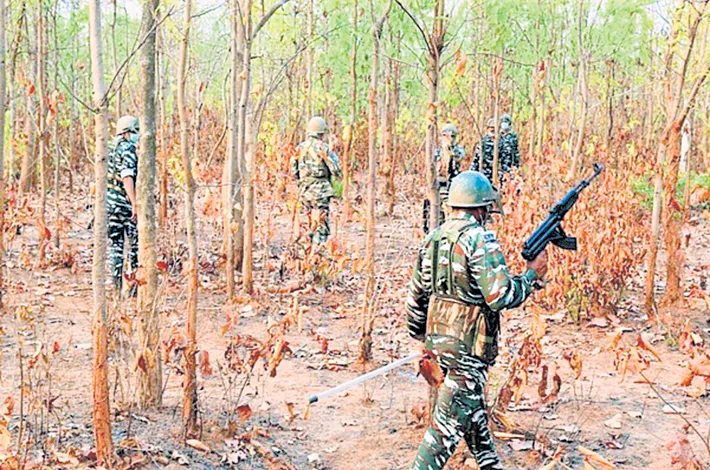Security forces intensify operations in Maoist-Dominated Dandakaranya region
28-04-2025 12:00:00 AM

metro india news I dandakaranya
In a significant escalation of anti-insurgency efforts, Indian security forces have launched a large-scale combing operation across the dense forests and rugged terrains of the Dandakaranya region, a longstanding stronghold of Maoist insurgents.
The operation, involving thousands of personnel from the Central Reserve Police Force (CRPF), state police, and specialized anti-Naxal units like the CoBRA (Commando Battalion for Resolute Action), aims to dismantle Maoist networks and restore state authority in one of India’s most volatile conflict zones.
The Dandakaranya region, spanning parts of Chhattisgarh, Odisha, Andhra Pradesh, and Maharashtra, has long been a hotbed of Maoist activity. Its thick jungles, remote villages, and sparse infrastructure provide ideal cover for the insurgents, who have waged a decades-long armed rebellion against the Indian state, citing grievances over land rights, resource exploitation, and marginalization of tribal communities.
The region’s strategic importance, rich in minerals and forest resources, has made it a focal point for both the Maoists and the government.
According to sources in the Ministry of Home Affairs, the ongoing operation was triggered by a surge in Maoist activities in recent months, including ambushes on security personnel, extortion of local businesses, and attacks on infrastructure projects. A senior CRPF official, speaking on condition of anonymity, revealed that intelligence inputs indicated Maoist plans to disrupt upcoming local elections in Chhattisgarh and Odisha. “The Maoists are trying to reassert their dominance in Dandakaranya. This operation is about neutralizing their command structure and ensuring safety for civilians,” the official said.
The operation, codenamed “Prahar,” began in early April and has already covered vast swathes of the Abujhmarh hills, Sukma, Bijapur, and Dantewada districts in Chhattisgarh, as well as parts of Malkangiri in Odisha. Security forces are employing a multi-pronged strategy, combining ground assaults, aerial surveillance, and community engagement to weaken the Maoist grip. Drones equipped with thermal imaging and high-resolution cameras have been deployed to track insurgent movements in the dense canopy, while elite CoBRA units are conducting surgical strikes on suspected Maoist hideouts.
In a major breakthrough last week, security forces neutralized a top Maoist commander, identified as Sudhakar Reddy, in a fierce encounter in Sukma. Reddy, a member of the Dandakaranya Special Zonal Committee, was wanted for over 50 cases of violence, including the 2010 Dantewada ambush that killed 76 CRPF personnel. The encounter also yielded a cache of weapons, including AK-47 rifles, improvised explosive devices (IEDs), and communication equipment, signaling the Maoists’ continued access to sophisticated arms.
However, the operation has not been without challenges. The inhospitable terrain, marked by steep hills, rivers, and monsoon-soaked forests, poses logistical difficulties for the forces. Maoists, well-versed in guerrilla tactics, have planted IEDs along forest trails and set up ambushes to slow down the advancing troops. On April 20, a CRPF jawan was injured in an IED blast near Gadchiroli, underscoring the constant threat faced by the forces. Additionally, the dense forest cover limits the effectiveness of aerial support, forcing troops to rely heavily on ground intelligence.
The operation has also raised concerns among local tribal communities, who fear being caught in the crossfire. Dandakaranya’s population, predominantly Adivasi (indigenous), has historically been wary of both the Maoists and the state. While the insurgents often exploit tribal grievances to recruit cadres, security forces have faced accusations of heavy-handedness, including arbitrary detentions and extrajudicial killings. To address these concerns, the Chhattisgarh government has deployed civic action teams alongside the forces, distributing food, medical supplies, and educational materials to win over local support.
“We are not just fighting the Maoists; we are fighting for the trust of the people,” said Rameshwar Yadav, a senior police officer overseeing the operation in Bijapur. “Our goal is to make the Adivasis feel secure and ensure they have access to development.” The government has also announced plans to accelerate infrastructure projects, including roads, schools, and healthcare centers, in the region to undermine the Maoists’ narrative of state neglect.
Despite these efforts, human rights activists have cautioned against the potential fallout of the operation. “Large-scale military operations in tribal areas often lead to displacement and alienation,” said Meena Kandasamy, a prominent activist based in Raipur. “The government must ensure that innocent villagers are not targeted and that their rights are protected.” Reports of alleged excesses by security forces, including the destruction of homes during searches, have already sparked protests in some villages.
As the operation enters its fourth week, security forces remain optimistic about weakening the Maoist insurgency. The Home Ministry claims that over 200 Maoist cadres have either been killed, arrested, or surrendered since the start of 2025, significantly denting the group’s operational capacity. However, analysts warn that the Maoists, known for their resilience, may retreat deeper into the forests and bide their time before launching counteroffensives.
The battle for Dandakaranya is as much about ideology as it is about territory. For the security forces, success hinges not only on neutralizing the Maoists but also on addressing the root causes of the insurgency—poverty, inequality, and disenfranchisement. As the combing operation continues, the nation watches closely, hoping for a resolution that brings lasting peace to this troubled region.








